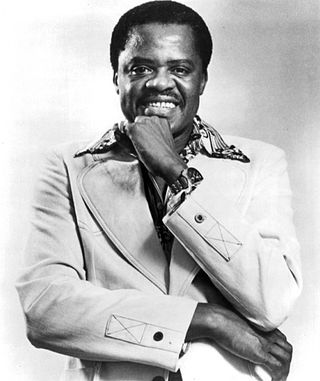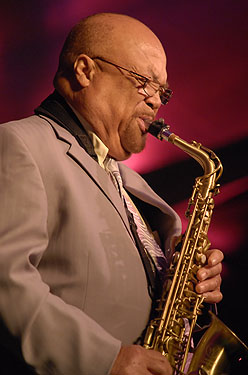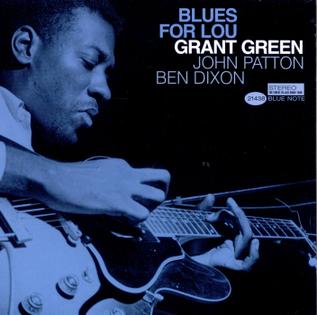Related Research Articles

Soul jazz or funky jazz is a subgenre of jazz that incorporates strong influences from hard bop, blues, soul, gospel and rhythm and blues. Soul jazz is often characterized by organ trios featuring the Hammond organ and small combos including tenor saxophone, guitar, and organ. Its origins were in the 1950s and early 1960s, with its heyday with popular audiences preceding the rise of jazz fusion in the late 1960s and 1970s. Prominent names in fusion ranged from bop pianists including Bobby Timmons and Junior Mance to a wide range of organists, saxophonists, and guitarists including Jack McDuff, Eddie "Lockjaw" Davis, and Grant Green.

Stanley William Turrentine was an American jazz tenor saxophonist. He began his career playing R&B for Earl Bostic and later soul jazz recording for the Blue Note label from 1960, touched on jazz fusion during a stint on CTI in the 1970s. He was described by critic Steve Huey as "renowned for his distinctively thick, rippling tone [and] earthy grounding in the blues." In the 1960s Turrentine was married to organist Shirley Scott, with whom he frequently recorded, and he was the younger brother of trumpeter Tommy Turrentine, with whom he also recorded.
John Patton was an American jazz, blues and R&B pianist and organist often known by his nickname, Big John Patton.

Earl Van Dyke was an American soul musician, most notable as the main keyboardist for Motown Records' in-house Funk Brothers band during the late 1960s and early 1970s.

David "Fathead" Newman was an American jazz and rhythm-and-blues saxophonist, who made numerous recordings as a session musician and leader, but is best known for his work as a sideman on seminal 1950s and early 1960s recordings by Ray Charles.
Roosevelt "Baby Face" Willette was an American hard bop and soul-jazz musician who played the Hammond organ.

An organ trio is a form of jazz ensemble consisting of three musicians; a Hammond organ player, a drummer, and either a jazz guitarist or a saxophone player. In some cases the saxophonist will join a trio which consists of an organist, guitarist, and drummer, making it a quartet. Organ trios were a popular type of jazz ensemble for club and bar settings in the 1950s and 1960s, performing a blues-based style of jazz that incorporated elements of R&B. The organ trio format was characterized by long improvised solos and an exploration of different musical "moods".
Frederick Roach was an American soul jazz Hammond B3 organist born in The Bronx, New York, United States. Roach's first commercial recordings were with saxophonist Ike Quebec for Blue Note Records in the fall of 1961. These sessions produced Quebec's albums Heavy Soul and It Might as Well Be Spring. In March of 1962, Roach recorded as a backing musician for the Thunderbird album by Willis Jackson. From 1962-64, Roach recorded 5 albums as a leader for Blue Note, and also recorded with Donald Byrd on the album I'm Tryin' to Get Home. Roach's original writing, steady basslines, and highly musical fleet-fingered right hand set him apart. From 1966-67 he recorded three more albums as a leader for Prestige Records, which are in a more commercial vein than his Blue Note dates. Roach's Prestige albums were his last commercial recordings.

James Wesley "Red" Holloway was an American jazz saxophonist.

Here 'Tis is an album by jazz saxophonist Lou Donaldson recorded for the Blue Note label in 1961 and performed by Donaldson with organist Baby Face Willette, guitarist Grant Green and drummer Dave Bailey.

The Natural Soul is an album by jazz saxophonist Lou Donaldson recorded for the Blue Note label in 1962 and performed by Donaldson with Grant Green, Tommy Turrentine, Big John Patton, and Ben Dixon.

Good Gracious! is an album by jazz saxophonist Lou Donaldson recorded for the Blue Note label in 1963 and performed by Donaldson with Grant Green, Big John Patton, and Ben Dixon.

Grant's First Stand is the debut album by American jazz guitarist Grant Green featuring performances by Green recorded and released on the Blue Note label in 1961. He is featured in a trio with organist Baby Face Willette and drummer Ben Dixon. Earlier recordings made by Green for Blue Note were released as First Session in 2001.

Blues for Lou is an album by American jazz guitarist Grant Green featuring performances recorded in 1963, but not released on the Blue Note label until 1999. The album combines recordings from two different sessions that featured Green with organist Big John Patton and drummer Ben Dixon. The title track was named for saxophonist Lou Donaldson.

Face to Face is the debut album by jazz organist Baby Face Willette featuring performances recorded and released on the Blue Note label in 1961.

Stop and Listen is the second album by American jazz organist Baby Face Willette featuring performances recorded and released on the Blue Note label in 1961. It features a version of the 1941 Harry Warren song "At Last," which at the time of the Stop and Listen recording sessions was on the R&B and Billboard Hot 100 record charts through Etta James' hit recording of the song.

Along Came John is the debut album by American organist John Patton, recorded in 1963 and released on the Blue Note label.
Ben Dixon was an American jazz drummer.

Accent on the Blues is an album by American organist John Patton recorded in 1969 and released on the Blue Note label.

Hootin' 'n Tootin' is the debut album by American saxophonist Fred Jackson, and the sole recording under his leadership, recorded in 1962 and released on the Blue Note label. The CD reissue added seven previously unissued bonus tracks from a later session.
References
- 1 2 DeKoster, Jim (March–April 2006). "The Dozens". Living Blues. Oxford, MS: University of Mississippi (182–187): 8. ISSN 0024-5232. OCLC 3759004.
- ↑ Burke, Tony (Winter 1987). "Be Good or Be Gone". Blues Unlimited. London, England: BU Publications (148–149): 53. ISSN 0006-5153.
- 1 2 Dahl, Bill (2003). "Billy Wright". All Music Guide to Soul: The Definitive Guide to R&B and Soul. Allmusic. V. Bogdanov, C. Woodstra, S. Erlewine. Milwaukee, WI: Hal Leonard. p. 777. ISBN 9780879307448 . Retrieved 2011-11-09.
- 1 2 3 4 5 6 7 8 Erlewine, Stephen Thomas. "Fred Jackson". AllMusic. Retrieved 2011-11-09.
- ↑ Dahl, Bill (September–October 1989). "Little Richard: The Formative Years". Living Blues. Oxford, Mississippi: University of Mississippi (88): 55–56. ISSN 0024-5232. OCLC 3759004.
- ↑ Dahl, Bill (2001). Motown: The Golden Years . Iola, WI: Krause. p. 57. ISBN 978-0-87349-286-7 . Retrieved 2011-11-09.